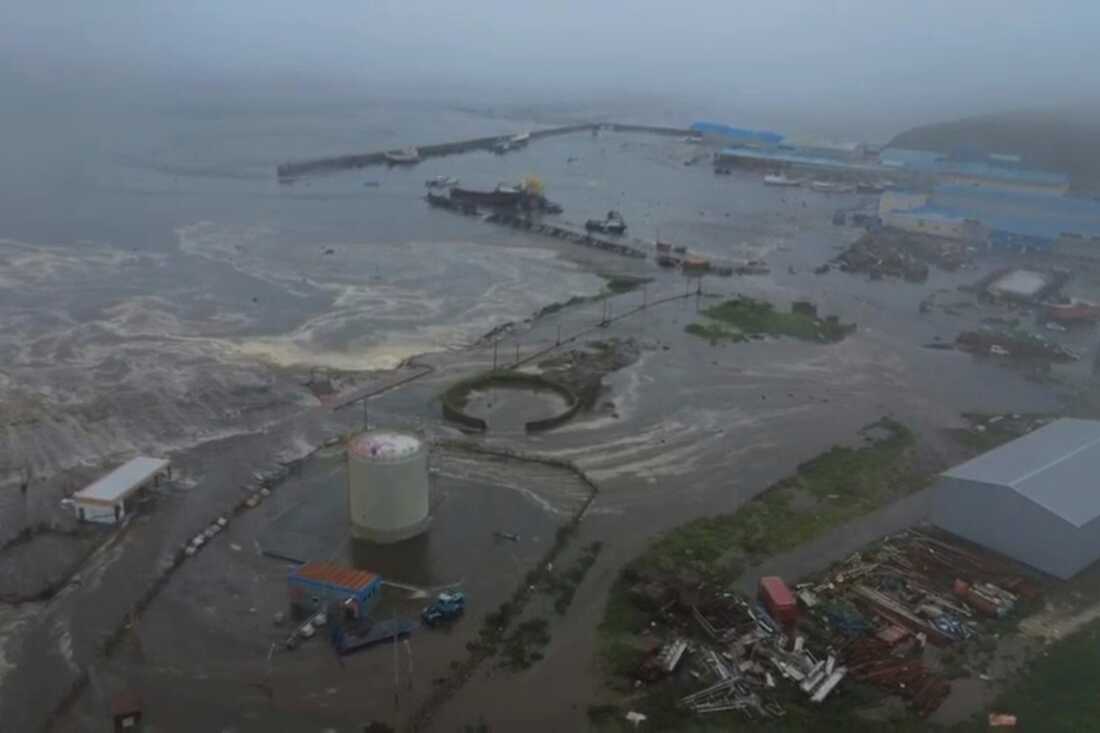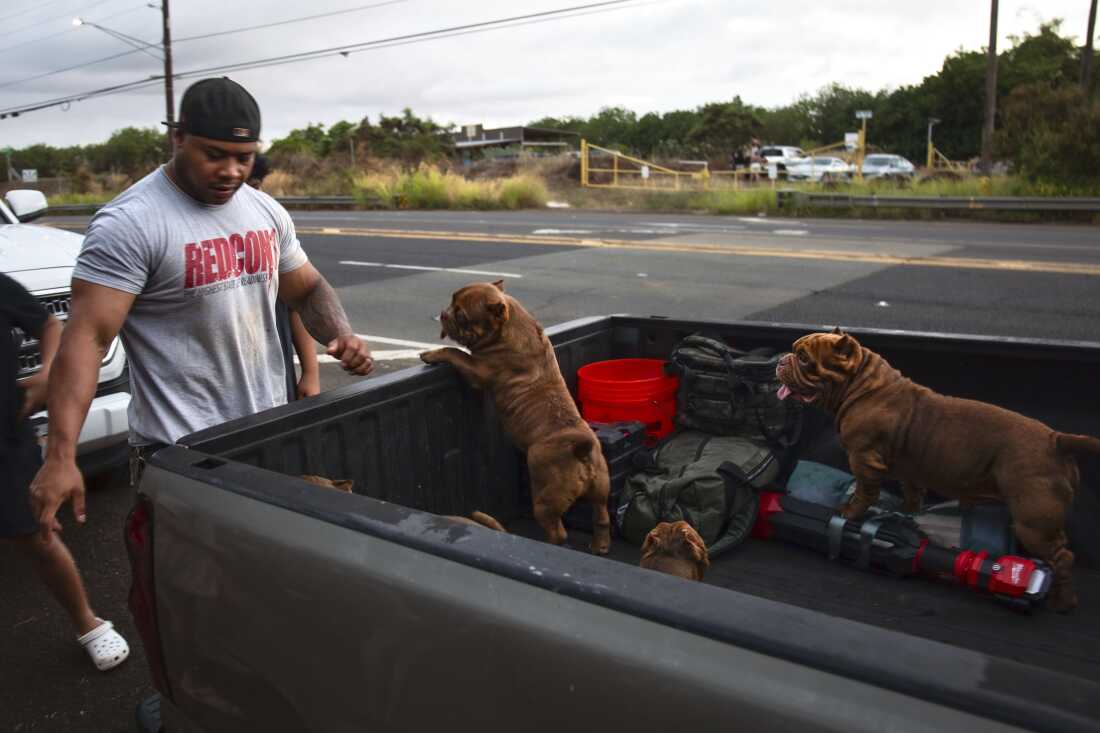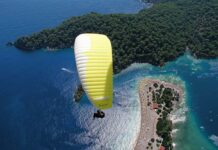
An officer sets up a roadblock during a tsunami warning in La Punta, Callao province, Peru on Wednesday. Connie France/AFP via Getty Images hide caption
toggle caption
Connie France/AFP via Getty Images
Tsunami waves reached parts of Hawaii, Alaska, California, Washington and Oregon on Wednesday, triggered by a powerful earthquake in eastern Russia.
A magnitude 8.8 earthquake hit near Russia’s sparsely populated Kamchatka Peninsula Wednesday morning local time — tying with two other quakes to become the sixth-strongest ever recorded on Earth, according to U.S. Geological Survey data.

Environment
8.8-magnitude earthquake sends tsunami into coasts of Russia, Japan and Alaska
Wednesday’s temblor flooded ports, damaged buildings and injured several people, according to Russian state news agency Tass, which also cites the Kremlin as saying there were no casualties.
The earthquake triggered tsunami advisories and evacuation orders across much of the Pacific, where fears of powerful waves had many people scrambling overnight.

This image, taken from a video released by Geophysical Service of the Russian Academy of Sciences, shows the aftermath of a tsunami hitting the coastal area of Severo-Kurilsk at Paramushir island of the Kuril Islands in Russia on Wednesday. Geophysical Service of the Russian Academy of Sciences/AP hide caption
toggle caption
Geophysical Service of the Russian Academy of Sciences/AP
As of Wednesday morning, both Hawaii and Japan have experienced tsunami waves but no substantial damage or injuries. Even after local officials downgraded their alerts, they are warning people to remain cautious along the coasts.
“We went into this tsunami warning, we got out of the area, we were safe — let’s return back and be safe,” James Barros, administrator for the Hawaii Emergency Management Agency, said at an overnight press conference, urging people to watch for floodwaters and check their structures as they return home.
Coastal areas of Alaska, California, Oregon and Washington state woke up to tsunami alerts and growing activity, according to the National Weather Service (NWS).
Officials are urging people to avoid beaches, waterways and shores for the foreseeable future, warning that tsunamis are a series of waves over the course of multiple hours. The first wave, they stress, may not be the largest.
Check out this time lapse of the Pillar Point Harbor in Half Moon Bay. Notice the abrupt up and down motion of the boats. A tsunami is not just one wave. It’s a packet of waves that can last for several hours. This rapid surging of water can create dangerous currents.#tsunami pic.twitter.com/qu5joaFgLG
— NWS Bay Area 🌉 (@NWSBayArea) July 30, 2025
While the risk isn’t completely gone, authorities say the U.S. seems to have averted serious damage.
Homeland Security Secretary Kristi Noem told reporters around 11:30 a.m. ET that the threat of a major tsunami “has passed completely.”
By that point, the last tsunami warning on the U.S. coastline — for a portion of Northern California — was downgraded to a tsunami advisory, meaning significant inundation is not expected even as waves reach over a foot high. All waves must be under one foot for three hours in order for advisories to be removed, according to the Washington Emergency Management Division.
Even as Los Angeles County beaches reopen, officials are warning people there — and all along the western coastline — to stay inland, away from dangerous currents.
“Whether an advisory is in effect or not, stay out of the water and harbors as currents will be strong,” the NWS says.
U.S. West Coast saw heightened warnings and wave activity

A lifeguard truck patrols Venice Beach amid a tsunami warning in Los Angeles early Wednesday. Apu Gomes/AFP via Getty Images hide caption
toggle caption
Apu Gomes/AFP via Getty Images
Even before sunrise, weather officials saw tidal surges along the U.S. West Coast.
The NWS Bay Area office tweeted that an initial tsunami wave hit San Francisco just after 1 a.m. local time. Within hours, it said the area was seeing tidal swings of 2 to 2.5 feet in as little as 15 minutes.
“This can create some seriously dangerous currents along beaches and harbors,” it wrote. “It’s just a good idea to stay away from the water today!”
In California, rapid fluctuations of 1 to 2 feet in water level were recorded around Monterey Bay, while Point Reyes reported what the NWS called the “highest tidal deviation yet:” 1.99 feet at 4 a.m. local time.
“This is more than 3 hours after the initial tsunami wave arrived,” it tweeted. “Wait for the all clear, this is far from over.”
Tsunami waves of 3.6 feet struck Crescent City, Calif., about 20 miles south of the Oregon border.
The Oregon Department of Emergency Management has said that portions of its coastline could see wave heights between 1 and 2 feet.
Meanwhile, the NWS Seattle office is warning of “strong and unusual currents,” primarily along the outer Washington coast.
It clocked its first tsunami waves around midnight, near the Washington state coastal communities of La Push and Westport. Three hours later, the NWS said it continued to see waves arriving on the coast as well as the Strait of Juan de Fuca, the narrow body of water separating Washington’s Olympic Peninsula from British Columbia’s Vancouver Island in Canada.
Parts of coastal British Columbia were also under tsunami advisories as of Wednesday morning.
Beyond the mainland U.S., high alerts continue

Cars sit at a standstill along the Pan-American Highway in Panama City after a tsunami warning was issued on Wednesday. Matias Delacroix/AP hide caption
toggle caption
Matias Delacroix/AP
Guam and a number of island nations in the South Pacific — including Fiji, Tonga, and the Philippines — have lifted their tsunami warnings. But other countries and territories are issuing fresh orders.
Peru’s emergency center issued a warning for its Pacific coastline, forecasting waves between 3.28 and 7.58 feet.
Asia
1 month after Myanmar’s devastating earthquake, many are still looking for loved ones
Authorities in French Polynesia are urging residents of the Marquesas Islands archipelago to brace for waves as high as 13 feet, Reuters reports.
Tsunami alerts are also in place in coastal Chile, part of Colombia and Ecuador. Its Oceanographic Institute of the Navy says the Galapagos Islands could see a wave of 4.6 feet by 9 a.m. local time.
And Mexico’s navy says its Pacific coast could see waves of 1 to 3.3 feet, according to the Associated Press.
In Hawaii, the worst seems to be over

CJ Jasper evacuates his family and their dogs to the side of Kunia Road to escape the tsunami threat in Kapolei, Oahu, Hawaii on Tuesday. Hawaii has downgraded its alerts as the tsunami threat moves across the Pacific Ocean. Michelle Bir/AP hide caption
toggle caption
Michelle Bir/AP
Hawaiians braced for impact overnight.
The streets were packed with people trying to drive inland, and cell phones blared with emergency alerts. All flights in and out of Maui were cancelled, leaving some 200 people stranded at the airport, according to Gov. Josh Green.
The main Hawaiian islands did see tsunami activity, with waves as high as 5 feet and minor flooding in some coastal areas. But no significant damage or injuries were reported.
National
Hawaiians seek higher ground as the island braces for tsunami
“So far we have not seen a wave of consequence, which is a great relief to us,” Green said at one of multiple Tuesday night press conferences.
The Pacific Tsunami Warning Center downgraded Hawaii’s tsunami warning to an advisory around 10:40 p.m. local time Wednesday, and evacuation orders were lifted soon after.
The center’s director, Chip McCreery, said overnight he felt confident that “at least we’re past the worst part of it, we’re not going to see any impacts bigger than we’ve already seen.”
Still, officials are warning people to look out for — and document — any damage, and say strong currents could still pose a risk to swimmers and boaters, Hawaii Public Radio reports.
Millions were told to evacuate in Japan

People watch a television broadcast of a tsunami warning for much of coastal Japan outside a gaming shop in central Tokyo on Wednesday. Richard Brooks/AFP via Getty Images hide caption
toggle caption
Richard Brooks/AFP via Getty Images
The Japan Meteorological Agency lifted tsunami warnings for most of Japan, but is still urging people to exercise caution near coastal areas and waterways, according to state broadcaster NHK.
It says more than 2 million people across 229 municipalities had at one point been urged to evacuate away from the shore and toward higher ground.

The Picture Show
10 Years Later, The Rescued Snapshots Damaged In Japan’s Tsunami
Tsunami waves were recorded along Japan’s Pacific coast, the news outlet says, including one or some 4.26 feet in Iwate prefecture and another of 2.62 feet in Hokkaido.
Japan is no stranger to powerful tsunamis. In March 2011, a 9.0-magnitude earthquake triggered a tsunami that killed some 20,000 people and destroyed the Fukushima Daiichi nuclear power plant, sending radioactive material into the air.
This most recent tsunami also prompted concerns about Japan’s nuclear plants, and all staff were evacuated from the Fukushima Daiichi and Fukushima Daini Nuclear power stations. The International Atomic Energy Agency tweeted Wednesday morning that “initial reports indicate no safety impact for nuclear power plants along [the] Pacific coast.”
NPR’s Juliana Kim contributed reporting from Oahu.












